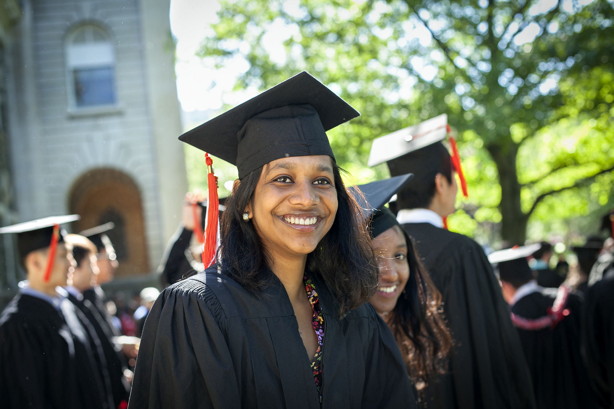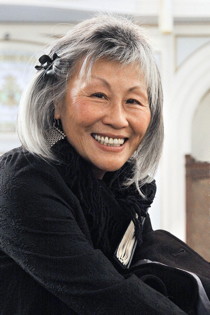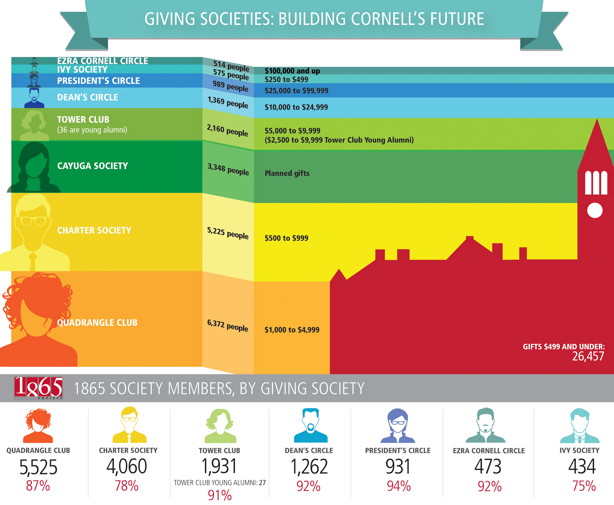CORNELL NOW
Cornell Now--2015

Tata scholar Pratima Satish.
Members of Tata scholars' inaugural class graduate
This May, three of the four Cornell students who entered with the inaugural class of Tata scholars graduated with undergraduate degrees. (The fourth, Pratima Satish, pictured above, needs one more semester to complete her dual degree in chemistry and materials science and engineering, but she walked in the procession with the others.)

Ratan Tata with David Skorton. See larger image
The Tata Scholarship was established in October 2008 with one of the largest gifts ever to an American university from a foreign benefactor: $50 million to fund two $25 million endowments: the Tata-Cornell Initiative in Agriculture and Nutrition and the Tata Scholarship for Students from India.
The gift came from the Tata Education and Development Trust, which is led by Cornell trustee Ratan Tata '59, B.Arch. '62. The Trust is a philanthropic entity of the family conglomerate, Tata Sons Inc., which Ratan Tata chaired until 2012.
Tata scholar Aadeetya Shreedhar is now pursuing a Master of Engineering degree in electrical and computer engineering at Cornell.
Sauhard Bindal works at Amazon in Seattle as a software development engineer, creating social games for Facebook and mobile platforms like Kindle, iOS and Android phones.
Ashwathi Iyer is back home working "for a company that makes solar-powered devices for villages and slums in India."
$6 million gift funds Fine Arts Library transformation
Berkeley, Calif.-based architect Mui Ho '62, B.Arch. '66, has made a $6 million gift commitment to overhaul and expand the Fine Arts Library (FAL) at Cornell. Scheduled for completion in 2017, the library will hold one of the country's most distinguished academic art and architecture collections in state-of-the-art, revamped facilities on the top two floors of Rand Hall, a 1912 campus icon.

Mui Ho. Photo: Bill Hocker. See larger image
"The FAL is absolutely essential to all students and scholars who work with visual material," said Kent Kleinman, the Gale and Ira Drukier Dean of the College of Architecture, Art and Planning. He foresees a luminescent, contemporary research center housing 250,000 volumes, ample digital resources and generous study spaces. "It will be a light-filled, 21st century library, glowing from behind the large industrial windows of Rand Hall – a perfect metaphor for conserving the old while erecting the new," said Kleinman.
"It is critical that Cornell keeps this world-class collection in a good environment," said Ho. "These books are important for students in architecture, arts, history and other disciplines on the Cornell campus. Most images found within this collection are not readily available on the Internet, and students, researchers and teachers need to use these books intensely."
A retired design faculty member from the University of California, Berkeley, Ho emphasized that accessing information is not only a mental act but a tactile and visual experience as well. "The digital age changes how students research their information," she said. "The physical handling of materials at a real scale and seeing the true color as intended is important – but digital representations will enable broader archiving and distribution of the important work of our alumni and faculty. As technology changes, the way the work is represented will, too."
Cornell's giving societies: Then and now

Infographic, Cornell's giving societies. Credit: Wendy Kenigsberg/University Communications/Marketing.
History has a way of retracing its meandering footsteps.
In 1963, Cornell's first giving society was established to honor the university's most committed donors. Originally to be christened the Ezra Cornell Society (with members dubbed as "Ezras") it was instead named the Tower Club, when Judge Mary Donlon '12 – the lone female member of the Cornell University Board of Trustees at the time and a staunch benefactor herself – objected to the masculine nickname.
Fifty years later, that first, abandoned moniker has been reincarnated in the university's newest giving society: Launched in 2013, the Ezra Cornell Circle honors donors at the $100,000 level.
As Cornell's supporters have grown in number over the years, so have its giving societies multiplied: the Tower Club (1963), Charter Society (1972), Quadrangle Club (1979), Dean's Circle (1984), President's Circle (1985), Cayuga Society (1993), Ivy Society (1997), 1865 Society (2013) and Ezra Cornell Circle (2013).
Additionally, established in 1981, the highest recognition of Foremost Benefactor was bestowed upon individuals who have provided exemplary service to the university and contributed a significant amount of financial support to Cornell.
Recounting the origins of Cornell's giving societies, Robert Harrison '76, chair of the Cornell University Board of Trustees, says: "When the Tower Club started half a century ago, 316 members had joined at the giving level of $1,000. Since then, the Tower Club has raised its sights four times to its current $5,000 level, with more than 2,000 members and growing."
Harrison points to the Ezra Cornell Circle as the latest testament to the commitment of Cornell's supporters, adding: "The variety of our giving societies speaks to the many ways alumni, parents and friends support the university. From Foremost Benefactors, who have given tremendous resources over a lifetime, to 1865 Society members, who contribute whatever they can for at least two years in a row, we are all doing our part to strengthen Cornell."
– Items written by Emily Sanders Hopkins and Jose Perez Beduya